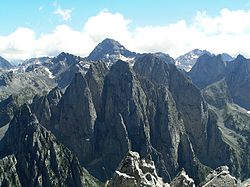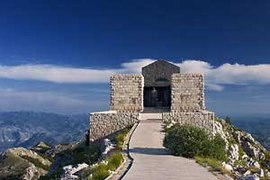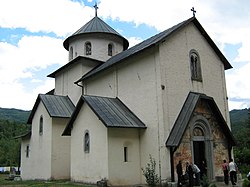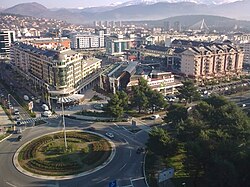Main points of interest
Coastal region
North Coast region
This notable coastal region is of primary interest to tourists in Montenegro. The Montenegrin Adriatic coast is 295 km long, with 72 km of beaches, and with many well-preserved ancient old towns. The main attractions along the north coast are:
- The old Town of Herceg Novi
- The Savina Monastery overlooking the entrance to the Bay of Kotor
- The old town of Kotor, listed with UNESCO World Heritage Sites
- Boka Kotorska (Bay of Kotor), with the ancient small town of Perast
- Porto Montenegro – Luxury Yacht Marina in Tivat (only city on Montenegrin coast to have airport)
- The old town of Budva, a well preserved old town
- Sveti Stefan, a small island hamlet turned into a luxury hotel
- Town Petrovac near Budva
As a part of the Institute of Marine Biology, in 2020 was established Adriatic Biodiversity Conservation Center ″Aquarium Boka″. [6] It is the first and only public aquarium in Montenegro. [7] It is also a unique institution in Montenegro that combines research and education to promote and practice the efficient conservation of marine wildlife [8] and a new attraction in the tourist offer of the city of Kotor. [9]
South Coast region
The South Coast region of Montenegro is considered one of the great new "discoveries" among world tourists. In January 2010, The New York Times ranked the Ulcinj South Coast region of Montenegro, including Velika Plaza, Ada Bojana, and the Hotel Mediteran of Ulcinj, as among the "Top 31 Places to Go in 2010" as part of a worldwide ranking of tourism destinations
The South Coast region, centered in Ulcinj, is popular in part due to the "Blue Flag beach" sandy beaches, eco-adventure activities, ancient fortress-cities, and vibrant nightlife. These destinations include:
- The old town of Ulcinj with its prominent battlements and Cyclopean walls, bustling nightlife and sea-side strand, and home of the Montenegro's longest pristine beach, Velika Plaza.
- The old town of Bar, Montenegro with its "living museum" at Stari Bar.
- Ada Bojana at the very south of Montenegro's coastline, with its famed daily fresh catch featured at the area's seafood riverside restaurants.16 km from Ulcinj.
- The vast water body and wildlife reserve Skadar Lake at Ulcinj's Salt Flats, one of the largest nesting places on the European continent for migratory birds.
- The pebble beach and massive olive groves at Valdanos.
- The beach, sea caves and pine resin in the air at Ulcinj's Ladies Beach, that for generations locals have known promise cures for infertility and other ailments.
- The only deep water harbor and commercial port in Montenegro, at Bar.
- Beaches, fortresses and villages on Skadar Lake
Northern Region
The Northern Region is the centre of Montenegrin mountain tourism. It has ski resorts, and is popular for its untouched nature. The entire area of Durmitor mountain and the Tara river canyon is protected as a national park, and listed with UNESCO World Heritage Sites.
Destinations in the North:
- The town of Plav and visitor summit 2211m above sea level (mountain peak) above Plav. Magnificent panoramic view of the mountains of Albania, Serbia and Montenegro. Along side Bogićevica summit 2533m and Zla Kolata summit 2535m which is the highest Peak in Montenegro. Mosque Sultanija the last Ottoman mosque in the Balkans. Plav Lake It is the largest glacial lake in Montenegro, and is also the best-known tourist attraction in the area. The Redzepagic Tower is the oldest and most interesting housing-defence facility in the city of Plav. It was built in 1671. The tower is now hosting the local ethnographic collection with more than 2000 exhibits which reach back as far as the middle ages to the present day. Hrid lake is known by locals as Fairy Lake and lake of happiness, is at 1970m and is the highest lake of Prokletijes and Montenegro. A refreshing swim best in July and August and not reachable by vehicles. Ali-Pasha's Springs (Ali Pasini Izvori) is one of the premium attractions in Prokletije National Park. The river is formed directly by outbreak from the soil, from the many small springs, a couple kilometers from Gusinje. There are multiple ethnic villages (Etno Selo) to enjoy the traditional food, herbal therapy and horse riding.
- The town of Pljevlja with the coat of arms of the Đurđevića Tara Bridge over the Tara (river), the largest canyon in Europe, the second-deepest canyon in the world. The canyon is known for the attraction of countless fast springs from the rocks during rafting.
- Ljubišnja triple Highland mountain chain and largest forest mountain range in Montenegro with the center in the village of Bobovo. Sandica Ubo the historic hamlet on the cliffs of the Tara river is part of the Durmitor National Park. Climbing, hiking, and photographing forested areas is a tourist practice. The habitat of wild horses is located on Horse field on Ljubisnja. Dairy products and organic food are produced by local farmers.
- Municipium S ... Komini Pljevlja archaeological site from the Roman period found by Arthur Evans.
- Heritage museum Pljevlja the most representative and richest museum in Montenegro with a unique piece of Cage cup.
- Monastery of the Holy Trinity near Pljevlja is famous as a place of pilgrimage known as a monastery for which a very famous medieval Enlightenment fraternity has guarded the bishop's scepter and a chest with holy bridges of one hand of Saint Sava for centuries which were moved to Church of Saint Sava.
- Husein-paša's Mosque in Pljevlja with the famous blue artistic arabesque on the ceiling of the tallest dome of the mosque and with the tallest minaret (42m) in the Balkans.
- Monumental memorial complex dedicated to the partisan fighters killed during the Battle of Pljevlja, the tallest monument to the anti-fascist movement in the Socialist Federal Republic of Yugoslavia.
- Memorial monument dedicated to the founding of Brigate Garibaldi formed in the valley of the village Mrzovici near Pljevlja opened with a ceremony with respect by the Italian president Sandro Pertini.
- The town of Žabljak on the Durmitor mountain, the most popular mountain tourism destination in Montenegro[ citation needed ]
- The town of Kolašin, another tourist destination, near the Biogradska Gora national park, the Bjelasica mountain and the ski-resort Bjelasica
- Biogradska Gora, with Biogradsko Lake, a national park and untouched virgin forest.
Central region
Although it is the most densely populated area of Montenegro, the central region has fewer tourist attractions. Notable are:
- Ostrog monastery, an Orthodox pilgrimage site
- Archeological remains of Duklja (Doclea) from Roman times outside Podgorica
- Cetinje the old royal capital of Montenegro
- Mount Lovćen, the national park and Petar II Petrović-Njegoš's Mausoleum have views of the surrounding area
- The Cetinje Monastery located in the old royal capital of Cetinje and the seat of the Metropolitanate of Montenegro
- The Morača Canyon
- The Morača Monastery overlooking the Morača Canyon
- Podgorica the country's capital
































